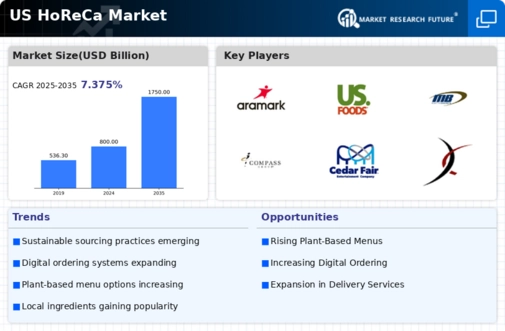Health and Wellness Trends
Health and wellness trends are significantly influencing the horeca market, as consumers increasingly prioritize nutritious and wholesome dining options. This shift is evident in the growing demand for organic ingredients and menu transparency, with approximately 40% of diners expressing a preference for establishments that provide detailed nutritional information. As health-conscious choices become mainstream, horeca businesses are adapting by incorporating healthier options into their menus, which may enhance customer loyalty and attract new clientele. Furthermore, the emphasis on wellness extends beyond food to include the overall dining experience, prompting establishments to create environments that promote relaxation and well-being. This focus on health and wellness is likely to shape the future of the horeca market.
Economic Recovery and Growth
The horeca market is poised for growth as the economy continues to recover. Recent data indicates that consumer spending in the food service sector has increased by 15% in the last year, signaling a robust demand for dining experiences. This economic recovery is bolstered by rising disposable incomes and a resurgence in social gatherings, which are critical for the horeca market. As more individuals return to dining out, establishments are likely to see an uptick in patronage, leading to increased revenues. However, businesses must also navigate rising operational costs, including labor and food prices, which could impact profitability. Thus, while the economic landscape appears favorable, strategic planning will be essential for success in the horeca market.
Evolving Consumer Preferences
The horeca market is currently experiencing a shift in consumer preferences, with a growing inclination towards diverse culinary experiences. This trend is reflected in the increasing demand for ethnic cuisines and plant-based options, which have seen a rise of approximately 30% in popularity over the past year. As consumers become more adventurous, establishments within the horeca market must adapt their menus to cater to these evolving tastes. Additionally, the rise of food delivery services has transformed how consumers engage with horeca offerings, leading to a significant increase in off-premise dining. This evolution in consumer behavior necessitates that businesses remain agile and responsive to changing demands, ensuring they stay competitive in the dynamic horeca market.
Regulatory Changes and Compliance
The horeca market is subject to a myriad of regulatory changes that can impact operations and profitability. Recent legislative developments regarding food safety, labor laws, and health regulations necessitate that businesses remain vigilant and compliant. For instance, new health codes may require establishments to invest in updated equipment or training, which could strain financial resources. Moreover, compliance with labor regulations, including minimum wage increases, can affect operational costs. As the regulatory landscape evolves, horeca market players must stay informed and adapt their practices accordingly to mitigate risks and ensure sustainable operations. This proactive approach to compliance is essential for long-term success in the horeca market.
Digital Transformation and Online Presence
The horeca market is increasingly embracing digital transformation, with establishments enhancing their online presence to attract and retain customers. Recent statistics reveal that nearly 70% of consumers research restaurants online before making dining decisions, underscoring the importance of a robust digital strategy. Businesses are investing in user-friendly websites, social media engagement, and online reservation systems to improve customer interaction and streamline operations. Additionally, the rise of mobile applications for ordering and payment is reshaping the customer experience, making it more convenient and efficient. As technology continues to evolve, horeca market players must leverage these digital tools to remain competitive and meet the expectations of tech-savvy consumers.






















Leave a Comment